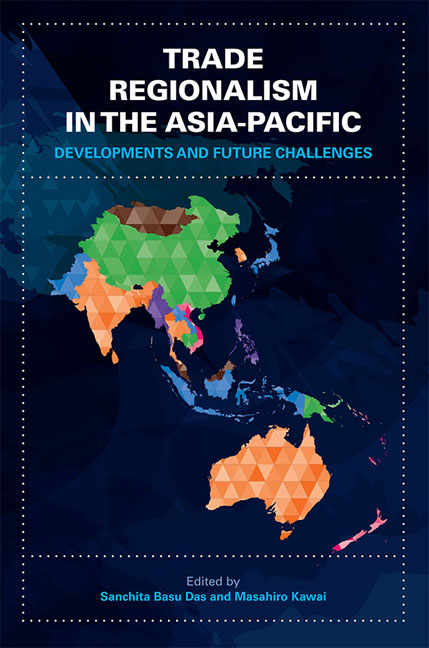Book contents
- Frontmatter
- Contents
- Foreword
- Acknowledgments
- List of Abbreviations
- The Contributors
- 1 Introductory Overview — Trade Regionalism in the Asia-Pacific: Developments and Future Challenges
- I The Trans-Pacific Partnership (TPP) Agreement
- II The Regional Comprehensive Economic Partnership (RCEP) Agreement
- 6 RCEP Prospect and Challenges: Political Economy of East Asian Integration
- 7 Challenges Facing the RCEP Negotiations
- 8 From AEC to RCEP: Implications for the CLMV
- 9 RCEP: An Indian Perspective
- III Regional Economic Integration: A Multi-stage Approach
- IV Old and Emerging Approaches to Asia-Pacific Regional Integration
- V Asia-Pacific Regional Integration: Towards Convergence?
- Index
8 - From AEC to RCEP: Implications for the CLMV
from II - The Regional Comprehensive Economic Partnership (RCEP) Agreement
Published online by Cambridge University Press: 05 July 2016
- Frontmatter
- Contents
- Foreword
- Acknowledgments
- List of Abbreviations
- The Contributors
- 1 Introductory Overview — Trade Regionalism in the Asia-Pacific: Developments and Future Challenges
- I The Trans-Pacific Partnership (TPP) Agreement
- II The Regional Comprehensive Economic Partnership (RCEP) Agreement
- 6 RCEP Prospect and Challenges: Political Economy of East Asian Integration
- 7 Challenges Facing the RCEP Negotiations
- 8 From AEC to RCEP: Implications for the CLMV
- 9 RCEP: An Indian Perspective
- III Regional Economic Integration: A Multi-stage Approach
- IV Old and Emerging Approaches to Asia-Pacific Regional Integration
- V Asia-Pacific Regional Integration: Towards Convergence?
- Index
Summary
INTRODUCTION
In the past decades, the Association of Southeast Asian Nations (ASEAN) has evolved rapidly to become one of the key emerging regional institutions in the world. As one of its key agendas, ASEAN has promoted progressive regional integration alongside the reduction of the intra-regional development gap. The process of ASEAN integration has been wide-ranging and inclusive, leading to significant benefits to members, even the less-developed ones such as Cambodia, Lao PDR, Myanmar, and Vietnam (CLMV). Although the “CLMV growth story is one ASEAN success story with lessons … on the potential benefits of economic integration” (ERIA 2014), maintaining the momentum for further improvement is essential.
The idea of the Regional Comprehensive Economic Partnership (RCEP) is not new. The initiative actually represents a continuation of the “Concentric Circle Strategy”, which gradually builds on ASEAN integration in the form of the ASEAN Economic Community (AEC) to be created by 2015 and ASEAN-plus integration with “ASEAN centrality”. The RCEP was initiated by ASEAN itself in 2011 with the Association's Framework for RCEP. In 2012, leaders of all sixteen economies — including ASEAN members, China, Japan, Korea, Australia, New Zealand, and India — supported and agreed to launch the RCEP negotiations. Fundamentally, the RCEP resembles the various efforts around the region for broader regional integration, such as the East Asian Free Trade Area (EAFTA) initiative by China and the Comprehensive Economic Partnership in East Asia (CEPEA) proposal by Japan.
Since the RCEP originates from ASEAN's aspirations, a couple of natural questions arise. The first is whether the RCEP arrangement can be really effective for sustaining growth and narrowing the development gap in the CLMV countries. The second question is whether the RCEP can benefit from the AEC framework. In answering these questions, one may need to start by identifying their possible impacts on these member economies. Complications introduced by the new context of Asia-Pacific integration — i.e., the ongoing Trans-Pacific Partnership (TPP) negotiations — should also be considered carefully even though not all the CLMV countries participate directly in the process. These questions and issues constitute the main analytical focus of this chapter.
The remainder of the chapter is structured as follows. Section 2 summarizes the main possible impacts of the RCEP on the CLMV countries.
- Type
- Chapter
- Information
- Trade Regionalism in the Asia-PacificDevelopments and Future Challenges, pp. 147 - 166Publisher: ISEAS–Yusof Ishak InstitutePrint publication year: 2016



